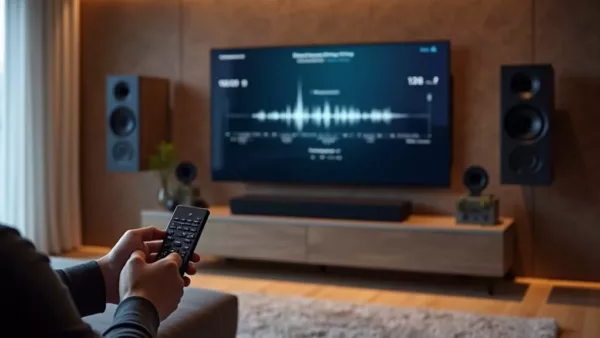
How to create a perfect home theater in your living room
Step into stunning visuals and immersive sound with these top 3 TVs—discover which model transforms your space into the ultimate home theater experience.

Calibrating your TV audio can completely change how you experience movies and shows. Instead of just turning up the volume, fine-tuning your sound settings can reveal hidden details and make dialogue, music, and effects more immersive. But how do you get the perfect balance? Learning how to calibrate your TV audio properly can unlock a whole new level of home entertainment.

Understanding your TV’s audio settings is key to getting the best sound experience from your television.
Many modern TVs come with various audio settings that let you adjust bass, treble, balance, and volume leveling. By exploring your TV’s audio settings, you can customize the sound to match your room’s acoustics and the type of content you’re watching.
Whether you want clearer dialogue during a movie or balanced sound for your favorite show, knowing how to use your TV’s audio settings ensures a great listening experience every time.
Choosing the right sound mode for your television can make a big difference in your viewing experience. The ideal sound mode depends on the type of content you’re watching and your listening environment.
For example, the “Standard” sound mode provides balanced audio, while the “Movie” sound mode enhances dialogue and special effects to immerse you in the action.
If you’re listening to music, the “Music” sound mode emphasizes clarity and richness for the best audio quality.
To find the perfect sound mode, try experimenting with different settings to match your preferences.
Selecting the ideal sound mode ensures you get the best audio experience for any program without needing to adjust additional settings each time.
After selecting the right sound mode, adjusting the bass and treble levels can greatly improve your audio quality.
Fine-tuning the bass enhances the depth of low frequencies, giving your music and dialogue a richer sound. Meanwhile, tweaking the treble sharpens high frequencies, making every sound clearer and more detailed.
Balancing bass and treble is key to avoiding distortion or overly sharp audio, ensuring a natural and enjoyable listening experience.
Balancing the left and right speakers is key to enjoying clear and immersive stereo sound.
When you balance the left and right speakers properly, you ensure that audio flows evenly from both sides, creating a natural and engaging listening experience. This balance prevents one speaker from overpowering the other, which is crucial for accurate spatial cues and sound clarity.
Whether you’re setting up a home theater or working with advanced audio technology, balancing the left and right speakers helps align sound perfectly with on-screen action, making your audio feel more lifelike and enjoyable.
Setting the Dialogue Enhancement feature is key to improving sound quality in your home theater system.
The dialogue enhancement setting boosts vocal frequencies, making speech clearer and easier to understand. By adjusting the dialogue enhancement feature while watching dialogue-heavy content, you can ensure voices come through crisp and natural.
Using the dialogue enhancement setting helps you enjoy movies and shows with better clarity, making every conversation stand out without overpowering background sounds.
When optimizing your audio setup, configuring surround sound options is key to boosting your entertainment experience.
Choosing the right surround sound format, like Dolby Atmos or DTS:X, ensures compatibility with your system and delivers immersive audio. Be sure to adjust speaker levels and distances for balanced sound distribution.
Properly enabling surround sound options in your TV’s audio menu enhances directional audio cues, making your sound richer and more engaging.
Configuring surround sound options is a simple step that transforms how you enjoy movies, games, and music with crystal-clear, immersive sound.
Volume leveling is a smart feature that keeps sound levels steady across all types of content. By using volume leveling, viewers won’t be startled by sudden loud commercials or struggle to hear quiet dialogue.
This consistent audio makes watching TV more enjoyable and less frustrating. With volume leveling, you can say goodbye to constantly adjusting the volume, as it ensures a smooth and balanced sound experience tailored perfectly to your preferences.
Embracing volume leveling technology enhances your TV’s audio performance, making every moment crystal clear and comfortable.
Using external audio devices effectively can significantly boost your TV’s sound quality, delivering a richer and more immersive audio experience than the built-in speakers alone.
When you connect soundbars, receivers, or speakers through HDMI ARC, optical cables, or Bluetooth, you ensure the best signal transmission for clear, powerful sound.
Adjusting the settings on your external audio devices, such as input levels and audio modes, works hand-in-hand with your TV’s calibration to create balanced, crisp audio tailored to your room and preferences.
Testing your sound calibration with sample clips is a smart way to ensure your audio devices deliver the best performance.
By using sample clips, you can easily check your sound calibration across different frequencies with consistent and controlled audio. These clips often include dialogue, music, and effects, helping you evaluate clarity, balance, and dynamic range.
Testing your sound calibration with sample clips not only fine-tunes your settings but also adapts your audio to fit your room’s acoustics and personal preferences.
Give it a try to experience clear, balanced sound every time!
To keep your audio performance at its best, regularly checking and adjusting your audio settings is key. By monitoring volume levels, balance, and equalizer settings, you can tailor your sound to fit your room acoustics perfectly.
Maintaining clean speaker surfaces and ensuring cables are secure also helps prevent any drop in audio performance. For the best results, schedule periodic recalibration using test tones or sample clips.
This keeps your audio performance consistent, adapting smoothly to environmental changes and equipment aging. Following these simple steps will help you enjoy top-quality audio performance every time.
Properly calibrating your TV for the best audio performance is key to enjoying clear and balanced sound every time you watch. To get the best audio performance from your TV, start by selecting the right sound mode and adjusting settings like bass, treble, and speaker levels. Features like dialogue enhancement and volume leveling also help deliver a richer listening experience. Regularly testing and recalibrating your TV’s audio ensures consistent quality, even as your room environment changes. Plus, adding external audio devices can take your TV’s sound to the next level. Taking the time to calibrate your TV for the best audio performance truly makes a difference in how you enjoy movies, shows, and games.

Step into stunning visuals and immersive sound with these top 3 TVs—discover which model transforms your space into the ultimate home theater experience.

Discover three top TVs that dramatically elevate your home theater experience—delivering stunning visuals and features you won’t want to miss.

Step into the world of perfect visuals by learning how to calibrate your TV—discover secrets that make every scene stunning and true to life.

Merging affordability with impressive performance, these top 3 budget TVs defy expectations—discover which models deliver quality without breaking the bank.

Get ready to discover the 3 best gaming TVs that deliver smooth, immersive gameplay with unbeatable performance and stunning visuals. Find out more inside!

Leading-edge 8K TVs promise stunning visuals, but is the technology truly ready to transform your home entertainment experience? Discover the truth inside.